New York 25 May - 02 June 2010 (original) (raw)
Home Donate New Search Gallery How-To Books Links Workshops About Contact
New York 25 May ~ 02 June 2010
25 May 26 27 28 29 30 31 May 01 & 02 June 2010 Tech Details
These are snaps from my trip to New York in the Spring of 2010. I brought a Canon 5D Mark II, Canon 50mm f/1.8, Canon 28mm f/1.8 and Canon 100mm f/2 lenses.
Unless mentioned otherwise, every shot here is exactly as it came out of the 5D Mark II, as shot on a Lexar 32GB 600x UDMA CF card.
My Canon 5D Mark II is set to Auto White Balance and Amber 5 (A5) WB SHIFT. Picture Style was left at STANDARD, however saturation was set to +3. Most of these shots are exactly as they came out of the camera as JPGs. If I played with them, I'll mention it, if not, it's what I got out of the Canon 5D Mark II.
If you'd like more details as to why I packed the camera I did and how it was set, see Tech Details.
25 May 2010, Tuesday
Today I flew from San Diego to New York City.
Photography is all about light. Towards the end of the day, the light looked great glancing across the wing.
My 50mm lens, as usual, was perfect. FARTing, I was drawn to the light, and I liked the way the three protuberances balanced. Looking deeper, I'm showing the patterns and shapes of the various wing surfaces. I'm careful not to cut off the shadow cast by the yellow tie-down.
What makes the shot is the light. The fact that there's an Airbus A320 in it is only secondary, but it makes a great model to show light because its shape lets us see what light is coming from what direction.
Ultimately, this shot is about the shapes of the various panels as seen here in a flat image. I see what I do because I try to see things as they'll look in flat, still images, not as three-dimensional, living, moving objects.
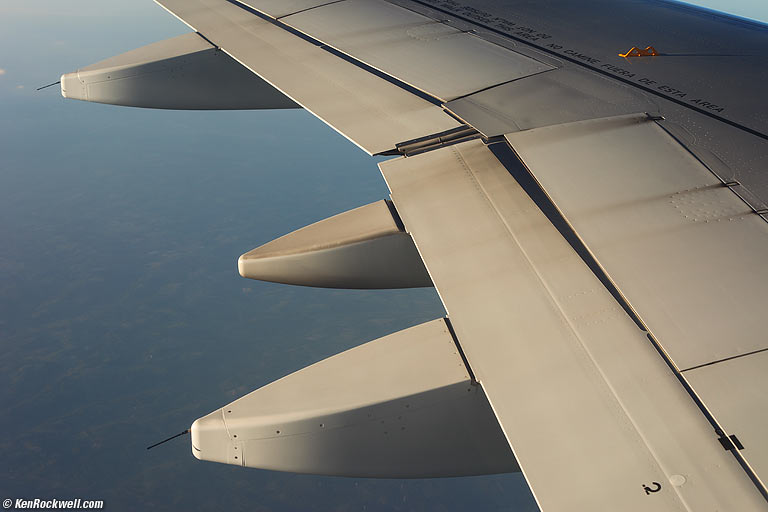
Light across a Wing and Three Blobs, 8:03 PM.
Canon 5D Mark II at ISO 50, Canon 50mm f/1.8, shifted Professional exposure (P) mode chose f/8 at 1/80.
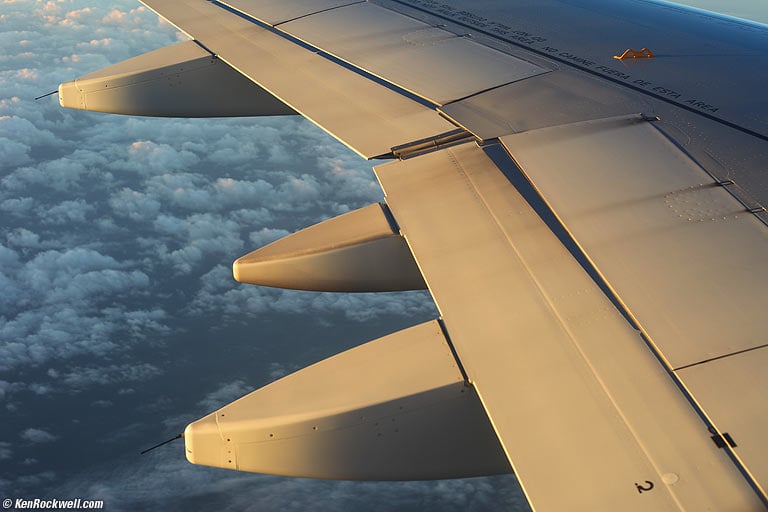
Light across a Wing and Three Blobs, 8:14 PM.
Canon 5D Mark II at ISO 50, Canon 50mm f/1.8, Professional exposure (P) mode chose f/5.6 at 1/50.
Did you catch that? It's only 11 minutes later, and the light went from good to great.
Look at the exposure data: it's also almost two stops darker as the sun is setting.
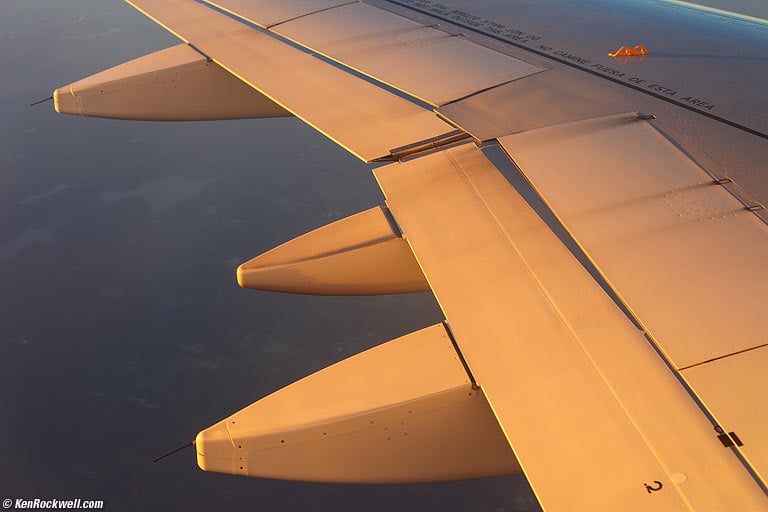
Light across a Wing and Three Blobs, 8:19 PM.
Canon 5D Mark II at ISO 50, Canon 50mm f/1.8, shifted Professional exposure (P) mode chose f/4.5 at 1/30.
This is even better, and it's just five minutes later than the previous shot. Look also at the exposure data: the light now is more than a stop darker than the previous shot, or three stops darker than the first.
Light changes very, very quickly as the sun goes down. We need to pay close attention!
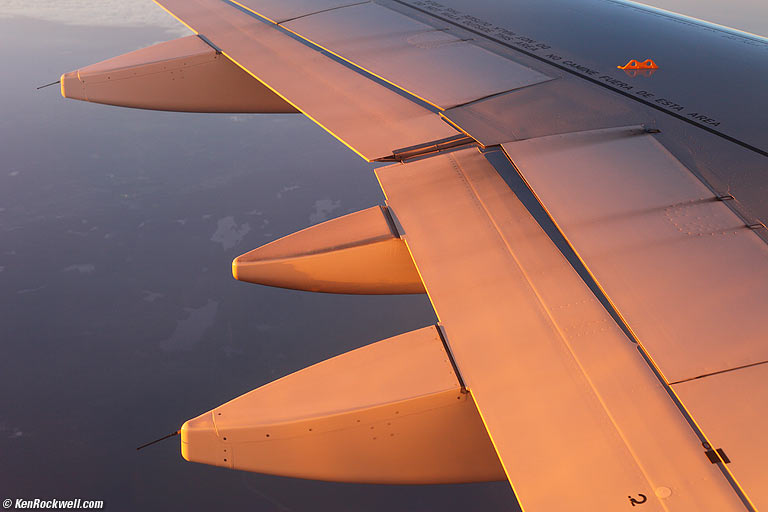
Light across a Wing and Three Blobs, 8:21 PM.
Canon 5D Mark II, Auto ISO stayed at ISO 200, Canon 50mm f/1.8, shifted Professional exposure (P) mode chose f/5.6 at 1/50.
Do you see how the light turned from gold to salmon in just 144 seconds? Also notice that I now used ISO 200 instead of ISO 50: the light is now almost four stops dimmer than the first shot just 18 minutes ago.
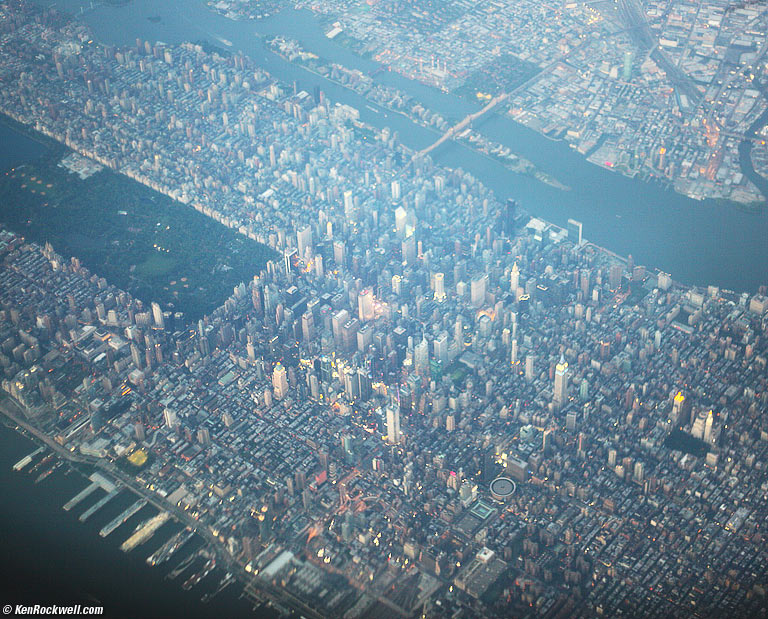
Midtown Manhattan from 16,000 feet, 8:26 PM.
Canon 5D Mark II, Auto ISO stayed at ISO 200, Canon 50mm f/1.8, Professional exposure (P) mode chose f/2 at 1/40.
I shot this out a different window looking almost straight down. I held the camera upside-down to lift the lens to clear the bottom of the airplane window. It's not that sharp because the thermal trail from the engine's exhaust is blurring most of the middle of the image, and the corners of the plastic windows aren't that sharp, either.
It was hazy; I pulled-down the darker part of an adjustment layer curve to give us a little more contrast, and also used a curves adjustment layer to burn-in (darken) the top corners to highlight midtown. The bottom corners were already as dark as you see here because parts of the window are blocking me.
Note my use of the high-speed of my $99 Canon 50mm f/1.8 lens. If I had used the much more popular 24-105mm f/4 L IS instead, I would have had to have shot at either grainy ISO 800 to stop the airplane motion, or shot at 1/10 of a second at f/4 at ISO 200. This is why I brought a Canon 50mm f/1.8 lens instead of a zoom, among other reasons.
Of course everyone else had their cameras packed away and was sleeping through all this. The most important thing in photography is to pay attention, and have some sort of camera — even your iPhone — with you at all times.
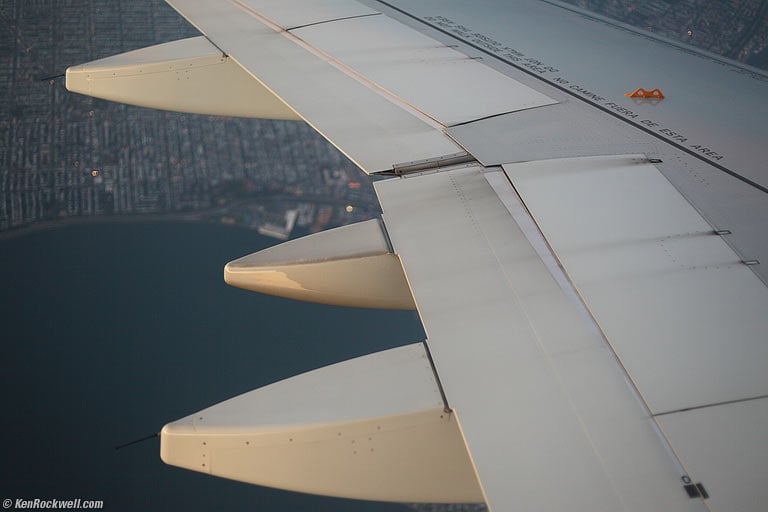
Light across a Wing and Three Blobs, 8:28 PM.
Canon 5D Mark II, Auto ISO stayed at ISO 200, Canon 50mm f/1.8, Professional exposure (P) mode chose f/2.2 at 1/40.
The sun is down. This is the wing lit by the light part of the sky. This is only seven minutes later than the most vivid wing shot above. Can you see ow totally dead it is by comparison?
People wonder how I get such great colors. 90% of it is paying attention so I can make my shot at just the right second as the light changes.
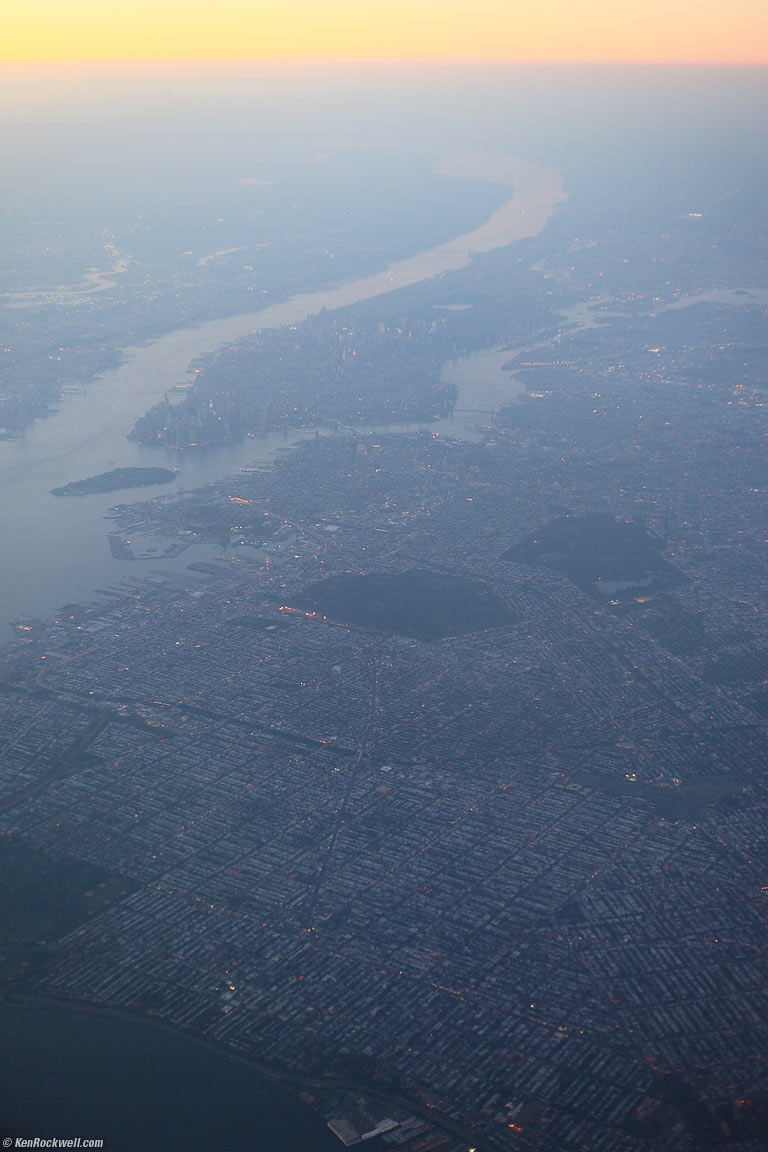
Queens, Brooklyn and Manhattan, 8:29 PM.
Canon 5D Mark II, Auto ISO stayed at ISO 200, Canon 50mm f/1.8, Professional exposure (P) mode chose f/2.5 at 1/40.
Again, bless the $99 Canon 50mm f/1.8. With an IS zoom, I doubt I'd get anything this clean or sharp at 250 knots.
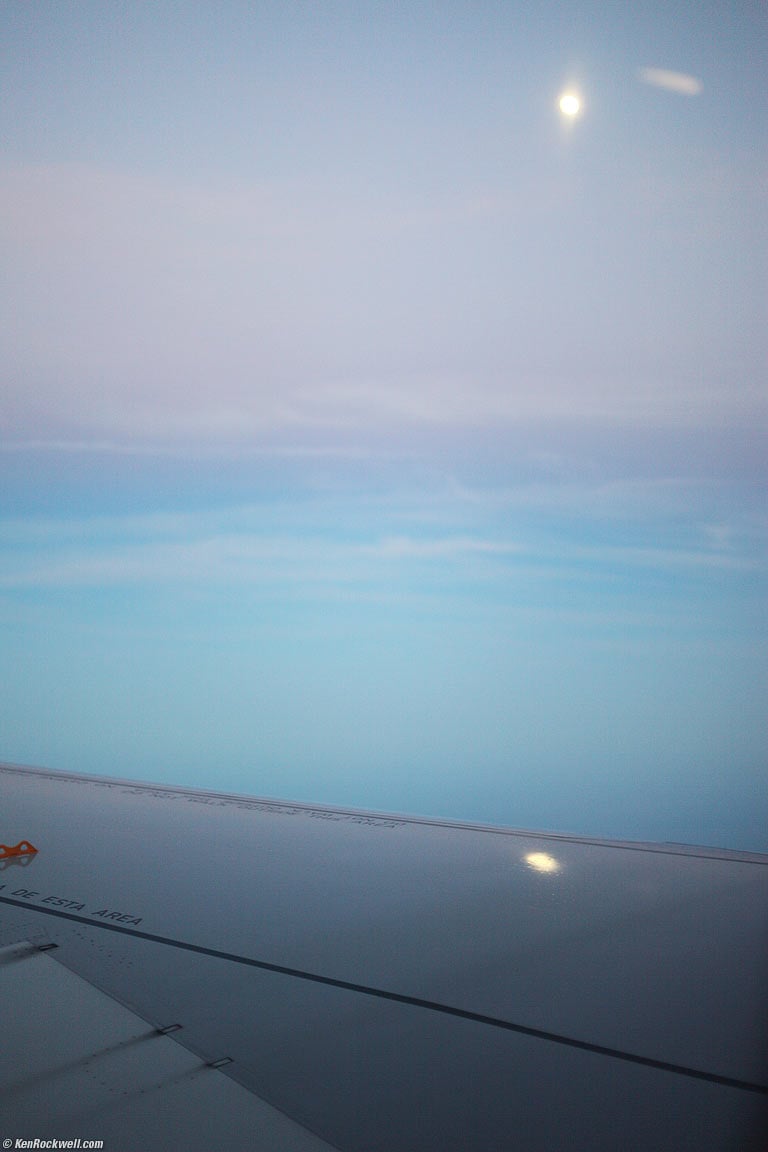
Airbus A320 Wing and Moon, 8:31 PM.
Canon 5D Mark II, Auto ISO stayed at ISO 200, Canon 50mm f/1.8, Professional exposure (P) mode f/2 at 1/40.
The second moon is a reflection from inside the plastic windows through which I was shooting.
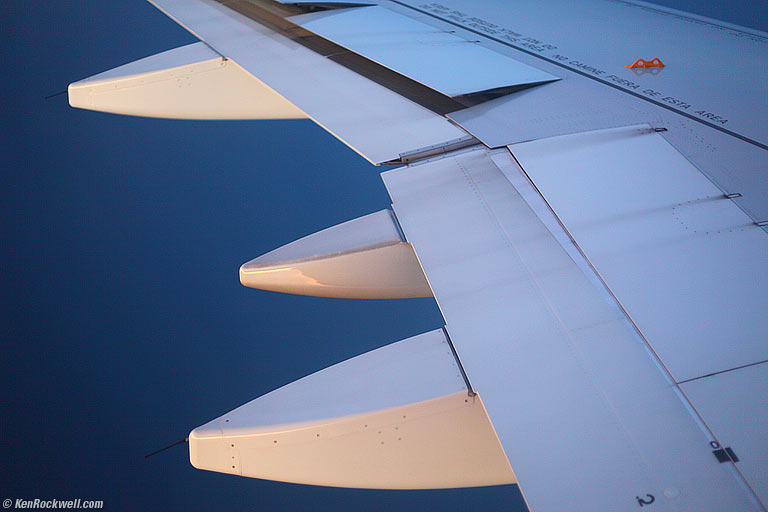
Wing and Fromundalight, 8:31 PM.
Canon 5D Mark II, Auto ISO chose ISO 400, Canon 50mm f/1.8, f/2 at 1/40.
What's fromundalight? It's light that comes from under. I suspect that the aircraft is at an attitude around the pattern where the band of orange light at the horizon is lighting the underside of the plane.
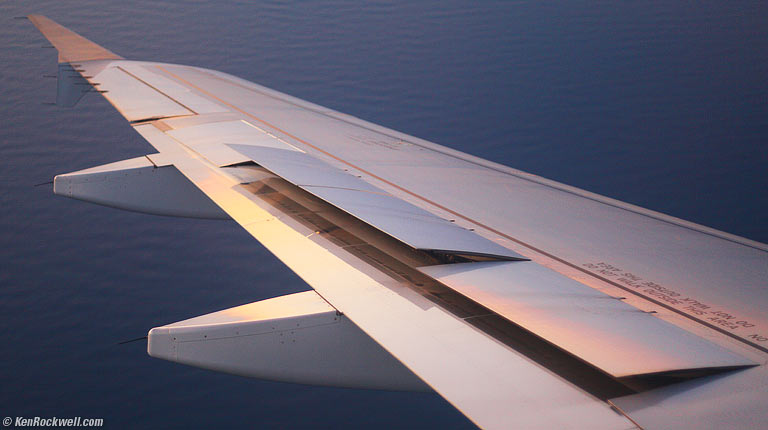
Spoilers, 8:33 PM.
Canon 5D Mark II, Auto ISO chose ISO 400, Canon 50mm f/1.8, f/1.8 at 1/40.
Here we've moved, and the light is roughly horizontal. This is one of the only two shots on this page where I tweaked the curves a little, and cropped a little, too.
I cropped a little because the highlight was further out on the wing. If I showed the entire image, half of it would be dull.
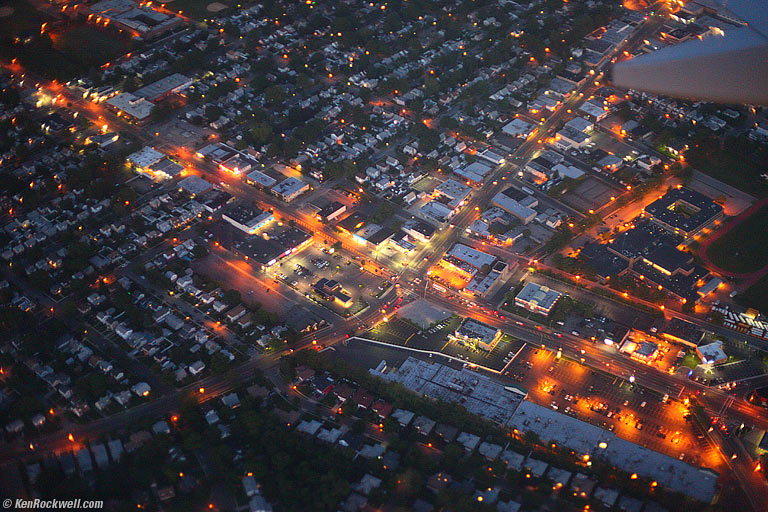
Queens, 8:43 PM.
Canon 5D Mark II, Auto ISO chose ISO 3,200, Canon 50mm f/1.8, f/2 at 1/40.
The super-fast f/1.8 speed of the Canon 50mm f/1.8 is ideal for aerial photography in dim light. (The Canon 50mm f/1.2 L is twice as good, five times as heavy and fifteen times as expensive). With an f/4 IS zoom, I'd need noisy ISO 16,000, or a one-eighth second exposure, to do the same thing as I can at f/1.8. Not bad for a $99 lens!
Call me crazy, but fast lenses are important. My best shots are made in transitional light; that is, light as day turns into night, and vice-versa.
The light has changed completely from 40 minutes go, but my camera is still set exactly as it was at the top of this page. The light is now eleven stops darker than it was at 8:03 PM, but by choosing Professional exposure (P) mode and Auto ISO let me pay attention to what was going on out the window instead of fiddling with my camera.
To get from ISO 50 at the top to Auto ISO, all I did was flick the 5D Mark II's command dial from my C3 to C1 positions, where C3 I have forced to ISO 50 and C1 is set to Auto ISO.
25 May 26 27 28 29 30 31 May 01 & 02 June 2010 Tech Details
Home Donate New Search Gallery How-To Books Links Workshops About Contact